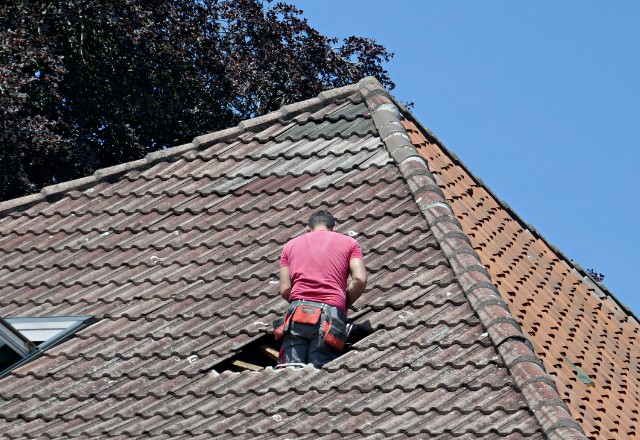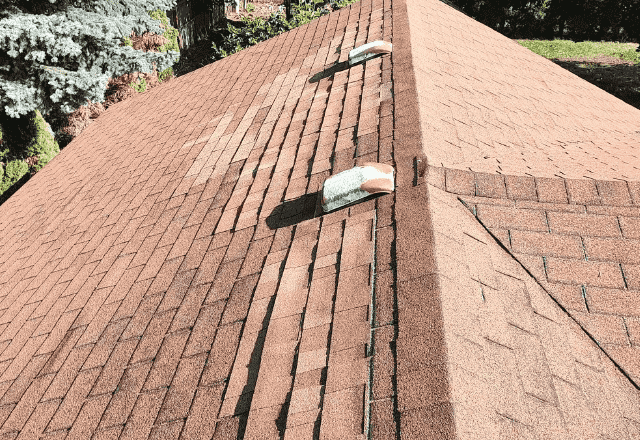A hole in your roof can be a major cause for concern, as it can lead to water damage, energy loss, and structural issues if left unaddressed. Whether caused by storms, falling branches, or general wear and tear, it’s essential to know how to repair a hole in your roof promptly to protect your home and prevent further damage. In this comprehensive guide, we’ll walk you through the process of identifying, assessing, and repairing a hole in your roof, providing helpful tips and insights along the way.
Identifying the Location and Extent of the Roof Hole
The first step in learning how to repair a hole in your roof is to accurately locate and assess the damage. Here’s what you should do:
- Look for signs of water damage: Check your ceilings, walls, and attic for any signs of water damage, such as stains, discoloration, or sagging drywall. These can help you pinpoint the general location of the hole.
- Inspect your roof: Safely access your roof to locate the hole. Look for missing, cracked, or damaged shingles, as well as any visible openings in the roof surface.
- Determine the size and severity: Measure the approximate size of the hole and assess the extent of the damage to the surrounding area. This will help you determine the best course of action for the repair.
- Check for structural damage: If the hole is large or has been present for an extended period, inspect the underlying roof structure, including rafters and decking, for signs of rot, mold, or other damage.
If you’re unsure about the severity of the damage or your ability to safely assess it, consider hiring a professional roofing contractor to perform a thorough inspection.
Gathering Necessary Tools and Materials
Once you’ve located and assessed the hole in your roof, it’s time to gather the necessary tools and materials for the repair. Here’s what you’ll need:
- Ladder
- Safety gear (e.g., non-slip shoes, gloves, safety harness)
- Utility knife
- Hammer
- Roofing nails
- Pry bar
- Roofing cement or sealant
- Patching material (e.g., metal flashing, mesh patch, rubber sheet)
- Replacement shingles (if necessary)
- Roofing felt (if necessary)
The specific materials you’ll need may vary depending on the type of roof you have and the size of the hole. Be sure to choose high-quality, durable materials to ensure a long-lasting repair.

How the Hole Size Affects the Difficulty of DIY Repairs
Hole Size | Repair Difficulty | Materials Needed | Estimated Repair Time |
Small (less than 1 inch) | Easy | – Roofing cement or sealant – Mesh patch or rubber sheet | 30 minutes to 1 hour |
Medium (1-6 inches) | Moderate | – Roofing cement or sealant – Metal flashing – Roofing nails – Replacement shingles (if needed) | 1-3 hours |
Large (more than 6 inches) | Difficult | – Professional assessment and repair – Potential structural repairs – Possible partial or full roof replacement | Variable; consult with a professional roofing contractor |
Please note that this information is provided for general guidance purposes only. The actual time and materials required for your specific roof hole repair may vary depending on factors such as the location of the hole, the type of roofing material, and the accessibility of the damage. Always prioritize safety and consult with a professional roofing contractor if you are unsure about any aspect of the repair process.
Safety Precautions for Roof Hole Repair
Before beginning any roof repair project, it’s crucial to prioritize safety. Here are some essential safety precautions to keep in mind:
- Use a sturdy ladder: Ensure your ladder is in good condition and placed on stable ground. Always maintain three points of contact when climbing and avoid overreaching.
- Wear proper safety gear: Non-slip shoes, gloves, and a safety harness can help prevent slips, falls, and injuries while working on your roof.
- Avoid working alone: Have a partner or spotter nearby to assist you and call for help in case of an emergency.
- Be mindful of weather conditions: Avoid working on your roof during wet, windy, or extreme weather conditions, as this can increase the risk of accidents.
- Know your limits: If you’re uncomfortable with heights, lack the necessary skills, or encounter a complex repair, don’t hesitate to contact a professional roofing contractor.

Step-by-Step Guide to Repairing a Hole in the Roof
Now that you’ve gathered your tools and materials and taken the necessary safety precautions, it’s time to begin the repair process. Follow these steps to learn how to repair a hole in your roof:
Step 1: Prepare the Area
- Remove any debris or loose material from around the hole using a pry bar or utility knife.
- Clean the area around the hole to ensure proper adhesion of the patching material.
- If necessary, remove any damaged or rotted decking or rafters and replace them with new material.
Step 2: Measure and Cut the Patching Material
- Measure the hole and add at least 2 inches of overlap on all sides to determine the size of the patching material needed.
- Transfer the measurements to your chosen patching material and cut it to size using a utility knife or scissors.
- If using metal flashing, bend the edges of the patch to create a slight lip that will help it fit snugly over the hole.
Step 3: Apply Roofing Cement
- Apply a generous amount of roofing cement or sealant around the edges of the hole, extending at least 1 inch beyond the opening.
- Use a putty knife or trowel to spread the cement evenly and ensure good coverage.
Step 4: Place the Patching Material
- Center the patching material over the hole and press it firmly into the roofing cement.
- Ensure that the patch is smooth and free of any wrinkles or air bubbles.
- If using metal flashing, nail the patch in place using roofing nails around the perimeter, spacing them about 1 inch apart.
Step 5: Seal the Edges
- Apply additional roofing cement or sealant around the edges of the patch, covering the nails (if used) and creating a watertight seal.
- Smooth the cement with a putty knife, feathering the edges to create a seamless transition between the patch and the surrounding roof surface.
Step 6: Replace Any Damaged Shingles
- If any shingles were damaged or removed during the repair process, replace them with new ones to maintain the integrity of your roof.
- Secure the new shingles with roofing nails and seal the edges with roofing cement to prevent future leaks.

Repairing Different Types of Roof Holes
The general steps for how to repair a hole in your roof may vary slightly depending on the size and location of the hole and the type of roof you have. Here are some additional considerations for different scenarios:
Small Holes or Punctures
For small holes or punctures, a simple patch using roofing cement and a mesh patch or rubber sheet may suffice. Follow the steps outlined above, cutting the patching material slightly larger than the hole and ensuring a tight seal around the edges.
Medium-Sized Holes
Medium-sized holes may require a more substantial patch, such as a piece of metal flashing cut to size and secured with roofing nails and cement. Be sure to overlap the edges of the hole by at least 2 inches on all sides and create a watertight seal.
Large Holes or Structural Damage
For large holes or extensive damage to the roof decking or rafters, a more comprehensive repair may be necessary. In these cases, it’s best to consult with a professional roofing contractor who can assess the damage and recommend the appropriate course of action, which may involve replacing a larger section of the roof or even a full roof replacement.
Different Roofing Materials
The specific materials and techniques used for repairing a hole in your roof may vary depending on the type of roofing material you have, such as asphalt shingles, metal roofing, or tile roofing. Be sure to use patching materials and sealants that are compatible with your roofing material and follow any manufacturer recommendations for repairs.
Post-Repair Maintenance and Inspection
After completing the repair, it’s essential to maintain the integrity of your roof and prevent future issues. Here are some tips for post-repair maintenance and inspection:
- Regularly inspect the repaired area: Check the patch periodically to ensure it remains secure and watertight. Look for any signs of cracking, lifting, or deterioration, and address them promptly.
- Keep your roof clean: Remove any debris, such as leaves or branches, that may accumulate on your roof to prevent damage and allow for better inspection.
- Schedule professional roof inspections: Have a licensed roofing contractor perform a comprehensive roof inspection at least once a year to identify any potential issues and ensure your roof remains in good condition.
- Address any underlying causes: If the hole in your roof was caused by a specific issue, such as a fallen tree limb or improper flashing, take steps to address the cause and prevent future damage.

When to Call a Professional Roofing Contractor
While many homeowners can successfully learn how to repair a hole in your roof, there are situations where it’s best to call in a professional roofing contractor:
- If the hole is large or extends through multiple layers of roofing material
- If you suspect significant structural damage to the decking or rafters
- If you’re unsure of the proper repair techniques or lack the necessary tools and safety equipment
- If the hole is in a hard-to-reach or high-risk area, such as near the edge of the roof or on a steep slope
A professional roofing contractor will have the expertise, experience, and equipment to assess the damage and perform a safe, reliable repair. They can also help you navigate any insurance claims or warranty issues related to the damage.
Can I prevent holes in my roof from occurring?
While it’s not always possible to prevent holes in your roof, especially those caused by severe weather events or falling debris, there are steps you can take to minimize the risk of damage and extend the life of your roof:
- Schedule regular professional roof inspections to identify and address any potential issues before they become major problems.
- Keep your roof clean and free of debris, such as leaves, branches, and moss, which can trap moisture and lead to deterioration.
- Trim any overhanging tree limbs that could potentially fall and damage your roof during storms or high winds.
- Ensure your attic is properly ventilated to regulate temperature and moisture levels, which can help prevent damage to your roofing materials.
- Address any issues with flashing, sealants, or shingles promptly to prevent water infiltration and subsequent damage.
- If you live in an area prone to severe weather, consider installing impact-resistant roofing materials or additional reinforcements to protect your roof from damage.
By taking these proactive measures and learning how to repair a hole in your roof when necessary, you can help ensure your roof remains in good condition and continues to protect your home for years to come.

Conclusion
Learning how to repair a hole in your roof is an essential skill for any homeowner, as it can help you quickly address damage and prevent further issues from developing. By following the steps outlined in this guide and taking the necessary safety precautions, you can successfully patch small to medium-sized holes and maintain the integrity of your roof. Remember to inspect your roof regularly, perform routine maintenance, and don’t hesitate to call in a professional when needed. With proper care and attention, your roof will continue to protect your home for years to come.



 509-201-4190
509-201-4190
